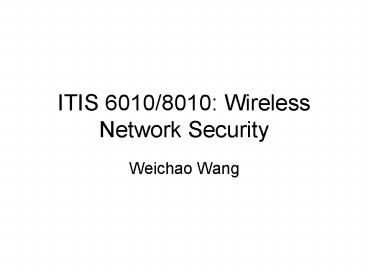ITIS 60108010: Wireless Network Security PowerPoint PPT Presentation
1 / 16
Title: ITIS 60108010: Wireless Network Security
1
ITIS 6010/8010 Wireless Network Security
- Weichao Wang
2
- Secure Efficient Ad Hoc Distance Vector (SEAD)
- Is based on DSDV
- Use hash chain to accomplish authentication and
avoid DoS - Assumptions
- The diameter of the network is shorter than m
hops - Use hash chains to authenticate route updates
- The hash results are used in groups of m
- New hash chains can be generated when old ones
are finished
3
- Very similar to SAODV use hash chain to make
sure a malicious node cannot decrement the
distance vector - Use sequence number to determine which group of
hash values will be used for authentication - Example
- Node S generates a hash chain with length 1000,
and network diameter is m. for sequence i, k
(1000 / m) i, the node will use hash value
h(km) to h(kmm-1)
4
- In this way, we prevent the fake sequence number
- A node will verify the hash value before updating
its routing table. It hashes again to match the
increased distance metric. - Why we try to reduce digital signature
- Too much computation overhead
- Can be used to conduct DOS attack
5
- Advantage over SAODV
- SAODV uses digital signature to protect the
sequence number, but SEAD binds sequence number,
hop metric, and hash chain together - We do not need to sign the final hash result
every time - Performance comparison to DSDV
- Higher delivery ratio but longer delay
- Higher packet and byte overhead
6
(No Transcript)
7
- Ariadne
- On-demand protocol based on DSR
- Based on TESLA to authenticate packets
- Need loosely synchronized clocks
8
- Intro of TESLA
- Is a broadcast authentication protocol
- Depend on clock synchronization and delayed
disclosure - Every node generates a hash chain, and the
previous hash value can be used to authenticate
the later values - The node discloses the hash result at a
determined interval - Use a not-published-yet hash value as key for
symmetric encryption or MAC - The receivers can authenticate the packet later
when the key is disclosed
9
- Example
- The clock synchronization error is ?, longest
end-to-end delay is t, node S will chose a key
that will not be disclosed until t2 ? - The receiver will examine the key and make sure
that it has not been disclosed. Otherwise, the
packet can be generated by an attacker - The receiver buffers the packet until the key is
disclosed to authenticate the packet
10
- Basic Ariadne Route Discovery
- Node S wants to locate a path to D, A to C in the
middle - Want to enforce three features
- S and D can authenticate each other
- Both S and D can authenticate the intermediate
nodes (maybe only one of S and D) - No intermediate node is missing
11
- Both pairwise keys and TESLA keys are used
- S and D authenticate each other with pairwise key
- The intermediate nodes can be authenticated by
- TESLA keys with delayed disclosure, but S has to
trust D to authenticate all intermediate nodes - Every intermediate node signs the route request
- Pair wise key between D and the intermediate
nodes - Per-hop hashing to make sure no node is removed
- Example Ariadne using TESLA
12
(No Transcript)
13
(No Transcript)
14
(No Transcript)
15
- Route Error with TESLA
- A node C finds that the link CD breaks, so it
sends a route error back to S with TESLA key
authentication. This path will be used until
delayed authentication is confirmed. (hint TESLA
uses delayed disclosure and authentication) - Question if we already have pairwise keys, what
is the advantage of using TESLA??
16
- Summary
- WatchDog PathFinder DSR
- SAODV Digital signature Hash chain, AODV
- SEAD Hash chain, DSDV
- Ariadne Pairwise key hash chain delayed
disclosure, DSR

